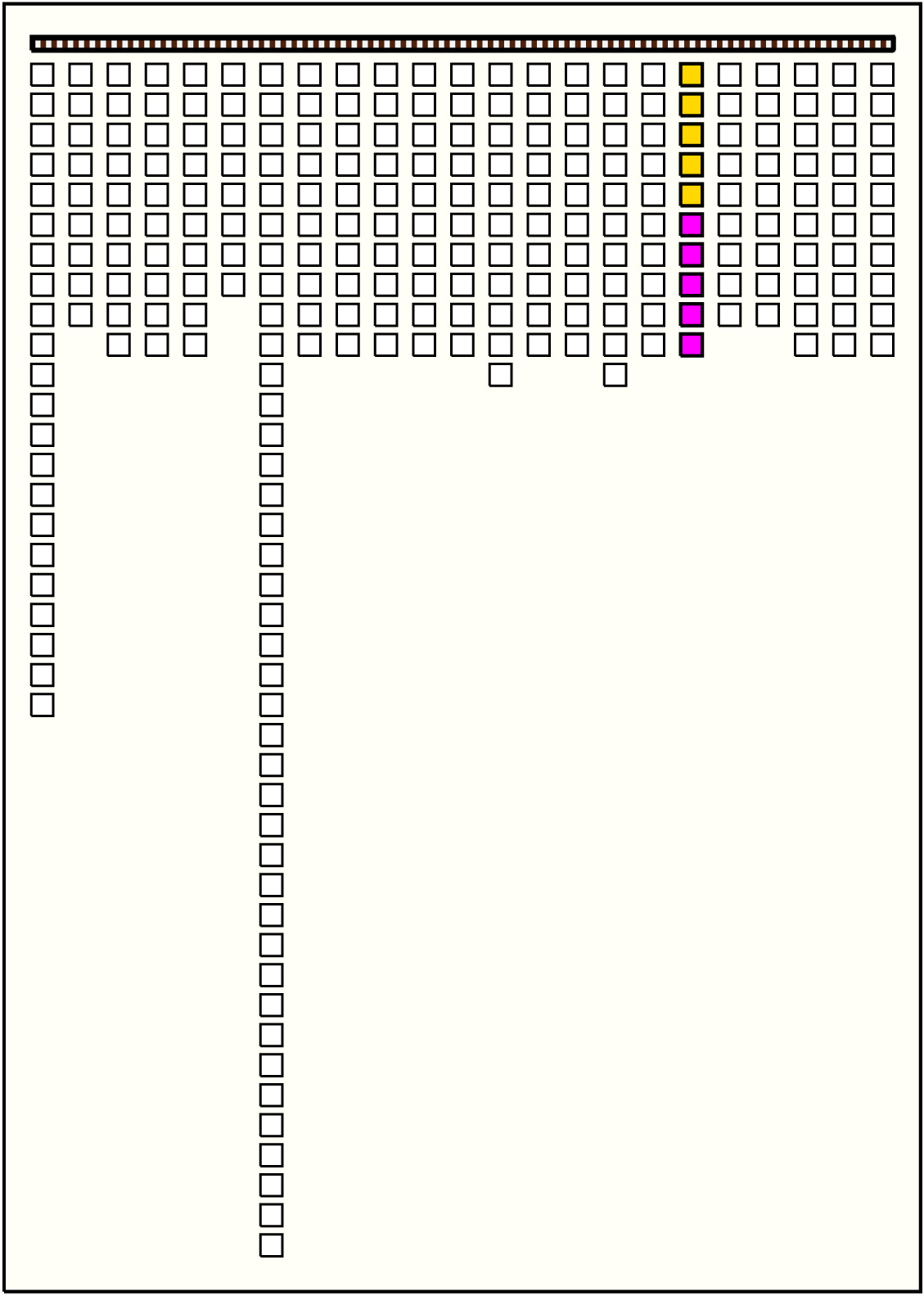AS128/KH0143 - Group Sum Bandss
Drawings:
Group Sum Bands:
Click on Image to View Larger
Individual Group Sum Bands: - Click on column name to sort
| # | Group Sum Bands Schema | Group Position 1 Based Index |
Split Index 1 Based Index |
Left Sum 1 Based Index |
Right Sum 1 Based Index |
|---|---|---|---|---|---|
| 0 |  | 017 | 6 | 16 = B@[18, 1]:3 + B@[18, 2]:3 + B@[18, 3]:4 + B@[18, 4]:3 + B@[18, 5]:3 | 16 = B@[18, 6]:4 + B@[18, 7]:3 + B@[18, 8]:3 + B@[18, 9]:3 + B@[18, 10]:3 |
Khipu Notes:
Ascher Databook Notes:
- Pendants 7-13 are irregularly attached to the main cord. They have the appearance of being retied onto it.
- Pendants 62-69 have been repaired where they are attached to the main cord. Two detached pendants stored with the khipu may be associated with this group of pendants. One of the fragments is KB-W with value 12, and the other is KB-W with value 40 and with a DB:W subsidiary with value 10.
- The pendants in this group are KB joined to W. However, all are broken just where the colors are joined.
- Pendant 199 is the same color as the pendants with which it is grouped but it differs from them in texture. It also differs from them in order of magnitude.
- AS127, AS128, and UR1176 were acquired by the Museum in 1933 with provenance Nazca. AS127 and AS128 are loosely tied together.
- By spacing, the khipu is separated into 6 parts.
- The first part is 1 group of 22 pendants all of value 0 (or blank).
- Part 2 is 5 groups of 8-10 pendants each. Each group is unified by having all pendants the same color. The first group has all values of 0; the values of the 4th group alternate 1, 0, 1, 0, etc. The last group in this part has only 8 pendants but may have had 10 (see #2 above).
- The 40 pendants in part 3 repeat the color pattern W, BS, 0D, DB:KB 10 times. The only subsidiaries are on the BS colored pendant and all are DB:W. For each of the 10 sets of 4 pendants, the values have the same relative magnitude: W > BS > 0D ≥ DB:KB.
- Part 4 is 5 groups of 10 pendants each. Each group is unified by having all pendants the same color. All pendant values are 0 (or blank).
- Part 5 is 10 groups of 9-11 pendants each. With the exception of the 11th pendant in the first group, each group is unified by having all pendants the same color.
- In the 2 groups that have 11 pendants, one of the pendants is exceptional by color or texture. The values of these exceptional pendants (Pl70 and Pl9 9) are related in the same way to the sum of the values of the pendants that follow them. The value of pendant 17 0 and its subsidiary equals 5 more than the sum of pendants 17 7-198. Then pendant 199 equals 5 more than the sum of pendants 200-221. [These pendants together span groups 2-6 of part 5. Since all the pendants in groups 7-9 are zero-valued, the sums could be extended to include them. ]
- Pendants 1-3 of groups 3-5 have the same relationships to each other as do pendants 5-7 of these same groups. In each case, the 9 pendants form the pattern:
Group Pi Pi+1 Pi+2 Group 3 a+1 a+1 a+1 Group 4 a a a Group 4 a a a
Where a=3 when Pi=P1 and a=4 when Pi=P5
- Part 6 is 1 group of 10 pendants all of color DB.
- Finally, returning to part 1, the pendant color order is related to the color order of the other groups on the khipu. (In #1 above, it is noted that some of the pendants in this group appear to be retied. Some pendants could, therefore, be missing or rearranged.)
- P2-4 are in the color order of groups 1-4 of part 2 with 1 omission.
- P5-7 are in the color order of the first 3 colors of the 4 color pattern of part 3.
- P8-12, with one exception, are the colors of the groups in part 4 but not in order.
- P13-22, with one exception, are in the color order of groups 1-10 of part 5.
- P1 is the color of the group in part 6.
